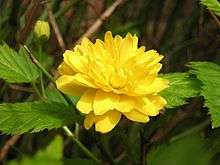Kerria japonica
| Kerria japonica | |
|---|---|
 | |
| Natural form | |
 | |
| Cultivar 'Pleniflora' | |
| Scientific classification | |
| Kingdom: | Plantae |
| (unranked): | Angiosperms |
| (unranked): | Eudicots |
| (unranked): | Rosids |
| Order: | Rosales |
| Family: | Rosaceae |
| Subfamily: | Amygdaloideae[1] |
| Tribe: | Kerrieae |
| Genus: | Kerria DC. |
| Species: | K. japonica |
| Binomial name | |
| Kerria japonica (L.) DC. | |
Kerria japonica, the sole species in the genus Kerria, is a deciduous shrub in the rose family Rosaceae, native to China, Japan and Korea. It is named after William Kerr, who introduced the cultivar 'Pleniflora'. The scientific genus name is also used as a common name Kerria.
Description
Kerria japonica grows to 1–3 m tall, with weak arching stems often scrambling over other vegetation or rocks. In the wild it grows in thickets on mountain slopes. The leaves are alternate, simple, 3–10 cm long, with a doubly serrated margin. The flowers are bright yellow, with five petals. The fruit is a dry single-seeded achene 4–4.5 mm long.[2]
Cultivation and uses
Kerria is valued in gardens for its bright yellow flowers, which appear in the spring. Two cultivars have gained the Royal Horticultural Society's Award of Garden Merit, K. japonica 'Golden guinea'[3] and the double-flowered K. japonica 'Pleniflora'.[4]
References
- ↑ Potter, D., T. Eriksson, R. C. Evans, S. Oh, J. E. E. Smedmark, D. R. Morgan, M. Kerr, K. R. Robertson, M. Arsenault, T. A. Dickinson, and C. S. Campbell (2007). "Phylogeny and classification of Rosaceae" (PDF). Plant Systematics and Evolution. 266: 5–43. doi:10.1007/s00606-007-0539-9. [Referring to the subfamily by the name "Spiraeoideae"]
- ↑ Li Chao-luang, Hiroshi Ikeda & Hideaki Ohba. "Kerria japonica". Flora of China. Missouri Botanical Garden, St. Louis, MO & Harvard University Herbaria, Cambridge, MA. Retrieved 8 July 2012.
- ↑ "RHS Plant Selector - Kerria japonica 'Golden Guinea'". Royal Horticultural Society. Retrieved 20 May 2013.
- ↑ "RHS Plant Selector - Kerria japonica 'Pleniflora'". Royal Horticultural Society. Retrieved 20 May 2013.
External links
 Media related to Kerria japonica at Wikimedia Commons
Media related to Kerria japonica at Wikimedia Commons Data related to Kerria at Wikispecies
Data related to Kerria at Wikispecies